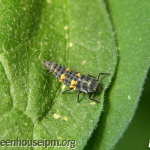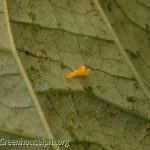Lady beetles
Description
There are many species of lady beetles that prey on aphids, the two-spotted ladybird, Adalia bipunctata, and the Convergent lady beetle, Hippodamia convergens, are the most common species that are available through biocontrol suppliers in Canada. Both adults and larvae are voracious predators of aphids, each capable of consuming up to 100 aphids per day. They are therefore useful for cleaning up hotspots.
Lady beetles are small, round to oval, shiny, dome-shaped beetles. Their larvae are oblong, rough-textured, and grey-black with yellow-orange spots or stripes.
Hippodamia convergens adults are very common in North America, and fit our common idea of what a lady beetle should look like. They are orange to red in colour with several black spots, and are about 7-8mm long.
Adalia bipunctata are similar in size, and they are either red with 2 black dots, or black with red dots.
Biology
Lady beetles lay yellow-orange oval eggs in clusters on plants near prey sources. The eggs hatch into larvae, that will continuously feed through 4 larval stages. While their main prey is aphids, they will opportunistically feed on other soft-bodied insects they encounter. They will stop eating to pupate; the pupae look like a smoother version of the larvae, with more orange-yellow spots, and is inactive during this stage. The adults will then emerge and continue feeding throughout their adult life that can last 2-3 months. The total life cycle of Adalia bipunctata and Hippodamia convergens from egg to adult takes approximately 3-4 weeks at 20°C.
Recommendations for use
Lady beetles work best when aphid numbers are higher, and should be introduced into hotspots.
Packaging
- May be shipped as larvae in buckwheat hulls or as adults
- Refer to the Quality Assurance of Biocontrol Products guide to determine the quality of the lady beetles at receipt at the greenhouse.
Distribution techniques
- Distribute only in infested areas, preferably where aphid populations are high
- Sprinkle product on leaves or in distribution boxes within the plant canopy
Introduction rates
- Preventative: not recommended
- Curative: 10-50/m2
Environmental considerations
- Lady beetles tolerate a wide range of conditions, and are active from 13-35°C and 30-90% humidity.
- They are most effective between 16-28°C
- Lady beetles adults may diapause when day lengths grow short and temperatures are cool
Monitoring
- Lady beetle larvae are diurnal and large enough to be seen easily within the crop;
- Clusters of yellow/orange eggs on leaves
- Lady beetles consume their prey entirely, so they do not leave aphid corpses behind
Factors affecting
- Please consult the Quick Reference Guide to Registered Pesticides made by OMAFRA for compatibility information of products registered in Canada. Koppert and Biobest also have pesticide compatibility information listed on their websites.



